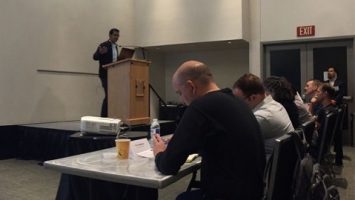
You may have heard about the Array of Things, one of the most highly publicized and groundbreaking projects in smart cities to date. If you haven’t, you’re in for a treat. We interviewed the Smart 50 Awards recipient about what “smart” means and what their work means for citizens of Chicago.
“Array of Things is an urban sensing project designed to better understand our cities. It collects high-resolution data on a city’s environment, infrastructure, and activity, creating a public, open resource that citizens, scientists, and governments can use to address urban challenges such as pollution, traffic safety, energy efficiency, and climate change. It is run by the University of Chicago and Argonne National Laboratory, with partners the City of Chicago and the School of the Art Institute of Chicago.
The centerpiece of the project’s first phase is the installation of 500 sensor “nodes” in the city of Chicago. We are also sharing a small number of nodes with partner cities such as Detroit, Denver, and Palo Alto, to start a global network of cities using our technology to collect urban data.”
Q: What does the term ‘smart city’ mean to you, and how does your project contribute to a larger smart city vision?
A: We prefer the term “community technology” for Array of Things (AoT). That vision better reflects the different stakeholders in our project — city governments, yes, but also the public, researchers, developers, and students. Residents will use existing and planned web portals and mobile applications to monitor factors such as air quality or congestion in their neighborhoods. Developers and students will use the data to create new applications that help individuals apply AoT insights to everyday life. Researchers will have unprecedented insight into new livability data, generating breakthrough discoveries in public health, sociology, climate, and beyond. City and community policymakers will be given powerful tools to investigate new data, combine it with other information, and make predictions about the city’s future that inform allocation of resources and policy changes.
Q: Why is the implementation of your project transformational in our current society?
A: AoT will provide researchers, policymakers and residents with unprecedented knowledge that will promote beneficial collaboration and innovation, and make Chicago more efficient, healthier and happier. Because the data collected by Array of Things will be open and available, it will effectively create a city-wide “fitness tracker” with tools and resources for residents to directly use the data, and will help the city to operate more efficiently, anticipating and proactively addressing potential problems.
Q: What advice did you receive along the way that helped you complete your winning project?
A: I think we’ve learned the most from our interactions with the public around the project. Through our website, we have received a number of suggestions about where we should install nodes and what types of data we should collect; for example, installing nodes in neighborhoods near O’Hare Airport that can monitor airplane noise. Additionally, we have also been contacted by dozens of cities and universities interested in using some form of Array of Things technology in their local setting. We are committed to an open and transparent process throughout the project, and will continue to engage citizens and communities to hear their concerns and suggestions.
Q: What advice would you give a city community or a solution provider looking to implement a municipal-level project?
A: A project of this scale would not have been possible without a strong partnership between a university and a city government. The city has helped us navigate the agencies necessary for implementation and public approval, while we have provided technology and research expertise outside the scope of municipal government. We would encourage any group interested in urban sensing to start by establishing a similar relationship.
Q: What does it mean to you to win the Smart 50 Awards?
A: We are flattered to receive this award, and are perennially thrilled at the interest Array of Things has generated. Since the project was launched, we’ve received inquires from more than 100 locations around the world. Our ultimate vision is to create a global network of cities using Array of Things nodes and feeding data into a common open-source platform, that will be useful for larger-scale studies of urban phenomena. Awards such as this one help us spread that message and encourage future collaborations.


